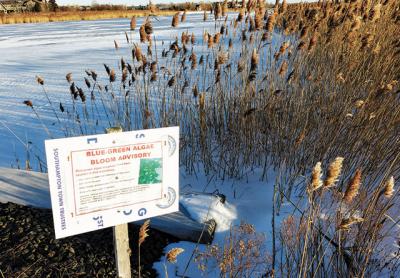More Wells Around Airport to Be Tested
More Wells Around Airport to Be Tested
The Suffolk County Health Department has expanded a survey of private wells in Wainscott following the detection of perfluorinated compounds, or PFCs, in four additional wells, bringing the total number of wells in which PFCs have been detected to 63.
The discovery of PFCs in wells near the East Hampton Airport, following a survey that began in August, represents “our highest-priority issue at the moment,” Councilman Jeffrey Bragman said at the East Hampton Town Board’s work session on Tuesday. The board, he said, understands its “obligation to protect the health and safety of residents,” and to that end is considering all options.
The expanded survey area now includes properties south of the East Hampton Airport lying east of Town Line Road and Sayre’s Path, west of Daniel’s Hole Road and Georgica Pond, and north of Wainscott Main Street.
The expanded boundaries were determined based on the current understanding of groundwater flow as depicted in the United States Geological Survey groundwater elevation maps and the location of known detections above the health advisory level in three private wells. The Health Department is planning to install groundwater-monitoring wells in the area to confirm the groundwater flow.
Supervisor Peter Van Scoyoc, referring to a news release issued by the county on Friday, said that the 63 wells that had detections of perfluorooctane sulfonate, or PFOS, and perfluorooctanoic acid, or PFOA, were among 138 test results received to date. Among those, three wells showed PFCs above the federal Environmental Protection Agency’s lifetime health advisory level of .07 parts per billion. PFOS and PFOA were not detected in the other 75 private wells sampled.
Though PFCs are currently unregulated, the E.P.A. has identified both PFOS and PFOA as contaminants of emerging concern. The agency issued the lifetime health advisory level of .07 parts per billion to protect the most sensitive populations, including fetuses during pregnancy and breastfed babies, against potential adverse health effects.
According to the E.P.A., studies on animals indicate that exposure to the two compounds over certain levels can also negatively affect the thyroid, liver, and immune systems, and cause cancer, among other effects.
The chemicals have been used in such industrial and commercial products as firefighting foam and coatings that repel water, oil, stains, and grease. People can be exposed to both PFOS and PFOA through air, water, or soil from industrial sources and from consumer products.
The well-testing program in East Hampton began after a survey by the State Department of Environmental Conservation, of facilities where products containing PFOS and PFOA may have been used, revealed that such products had been used at the airport.
Mr. Van Scoyoc encouraged residents in the survey area to have the Health Department test their wells. A free test can be scheduled by calling the department’s office of water resources at 631-852-5810. The town is working closely with the D.E.C, the Suffolk County Water Authority, state and local officials including Assemblyman Fred W. Thiele Jr., Senator Kenneth P. LaValle, and Legislator Bridget Fleming so that the resources are brought to bear to ensure safe drinking water for residents, he said.
The D.E.C. is continuing a study to determine the source of the contamination, the supervisor said. “We will continue to press for the resources necessary to address this,” he said, and the issue will be a regular aspect of the board’s work sessions. In addition, he said, the town will continue to provide bottled water to residents in the survey area who use a private well for drinking water. Delivery can be arranged by calling the town’s purchasing department 631-324-4183.
In other news from the Tuesday meeting, Councilwoman Kathee Burke-Gonzalez announced that she is stepping down as the board’s liaison to the airport after four years. Ms. Burke-Gonzalez, who was re-elected to serve a second term in November, said that she plans a greater focus on “the human side” in town government, including construction of a new senior citizens center, adolescent mental health, the planned emergency care facility to be operated by Stony Brook Southampton Hospital, and the needs of the Latino community. “I’m really excited,” she said.
In the airport, which has long rattled residents living under flight paths to and from it, Ms. Burke-Gonzalez had taken on “one of the most difficult topics,” Mr. Van Scoyoc said. “You really concentrated, and worked very hard to strip away a lot of myths that surrounded the issue. It’s been a very constructive four years.”
He acknowledged successes and failures: Three 2015 laws restricting access to the airport in order to reduce noise were later struck down. Last year, the United States Supreme Court opted not to review that decision. The board, he said, will continue to work toward meaningful restrictions on aircraft takeoffs and landings.
Sylvia Overby, the deputy supervisor, and Mr. Bragman will succeed Ms. Burke-Gonzalez as co-liaisons. Mr. Bragman, who was elected to the board in November, said in an August debate among Democratic Party candidates that “airport noise was harming thousands of people” and that helicopters “have no business in our community.”
On Tuesday, Ms. Overby said that, “We feel the airport needs some co-parenting,” and referred to the application procedure known as a Part 161 process that airports must perform when proposing noise or operational restrictions on aircraft. The board has hired a law firm to prepare the Part 161 application.
The board also appointed Joanne Pilgrim as executive assistant to the supervisor. Ms. Pilgrim was a longtime reporter and associate editor at The Star and covered the town board until the end of 2017. She replaces Alex Walter, who served in that role under Supervisor Larry Cantwell.




